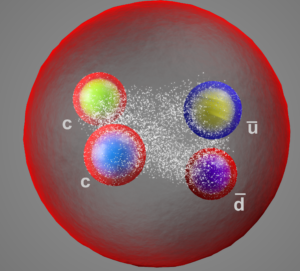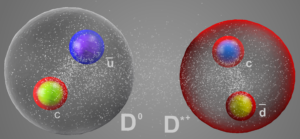The LHCb experiment at CERN has discovered a new particle consisting of four quarks, including two charm quarks. This is unusual: particles usually consist of two or three quarks, not four. Two charm quarks were never seen before.
This was announced by LHCb at the EPS virtual conference for high-energy physics from Hamburg. According to the standard model, the particle world has quarks and leptons, which make up all matter. LHCb is one of four large detectors in the Long Hadron Collider at CERN.
The new Tcc+ particle is sometimes created briefly in violent proton-proton collisions at the accelerator in Geneva. It consists of two charm quarks and an antiup- and antidown-quark. Until now, only tetraquarks with a charm and an anti-charm were known, or with only one charm.

No Nikhef researchers were directly involved in the new result. Nikhef does have a significant role in the LHCb experiment as a whole. For example, Nikhef physicist Niels Tuning is physics coordinator for the international collaboration.
The construction from quarks of particles is the domain of the strong nuclear force. In matter particles, quarks always occur in triplets in so-called hadrons. In addition, mesons are known, which consist of special pairs of quarks. Experiments have shown this for a long time.
Tetraquarks (and pentaquarks with five quarks) were predicted as early as the 1960s, but only really spotted in 2004 and more frequently at LHCb as of 2014. The quartets and quintets are the subject of much theoretical debate because they fit poorly into the theory of the strong nuclear force. Physicists call the states “exotic” for this reason.
There are two possible explanations for the exotic states. They could be two D-mesons stuck together, known particles made up of two quarks, each a charm with an anti-up or anti-down. Another view is that they are four equally real bound quarks. The measurements are inconclusive on the best description of the new tetraquarks.

The discovery of the tetraquark with two charm quarks comes more than thirty years after theorists predicted its existence in 1988, including by Utrecht professor John Tjon (1937-2010).
Other accelerator experiments at Nikhef are also reporting their latest results this week on EPS.